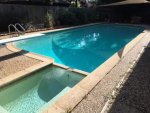I’m a new pool owner and very glad I found the forum. Been taking care of chemistry myself and recently bought an M400 robot per what I’ve learned here. So far so good.
When we bought the house we knew the plaster was pretty bad and would need to be re-done. We plan to be in this house forever and while budget is a concern I’m willing to invest some money into making the pool really great for years to come.
I’m not really sure what’s all possible in terms of things I could do to “upgrade” the pool. After reading many posts on TFP, here are some thoughts but I’m interested in what others might suggest:
What else would you consider to upgrade this pool?
What’s the ideal time of year to resurface a pool (Houston, TX)?
Currently it doesn’t seem like much gets to my one skimmer. I just ordered a replacement for the weir door which is broke so I hope that helps but are there other things I could do to help improve that? I’m thinking I’ll add a PoolSkim now.
See my signature for details on the pool equipment. I’ve got 1 skimmer, and 4 pool returns (3 in shallow end and 1 in spa) and 2 spa returns. I also have a custom cover which seems invaluable in the fall/winter as there’s LOTs of trees around.
Thanks very much for any input or advice!



When we bought the house we knew the plaster was pretty bad and would need to be re-done. We plan to be in this house forever and while budget is a concern I’m willing to invest some money into making the pool really great for years to come.
I’m not really sure what’s all possible in terms of things I could do to “upgrade” the pool. After reading many posts on TFP, here are some thoughts but I’m interested in what others might suggest:
- Some sort of pebble surface that’s more durable than plaster. (I need to research the options more)
- Add a SWG. At ~35k gallons is a 60k generator big enough... do they get bigger than that?
- Automation of some sort. Really I’d just like to be able to switch water and heat to the spa from inside the house. I don't really know what my options here are yet.
- Variable speed pump. (Again, need to research more, but seems like this is often recommended in these forums)
- Re-do the coping along the edge, or at least re-do the grout which is all cracked and ugly looking
What else would you consider to upgrade this pool?
What’s the ideal time of year to resurface a pool (Houston, TX)?
Currently it doesn’t seem like much gets to my one skimmer. I just ordered a replacement for the weir door which is broke so I hope that helps but are there other things I could do to help improve that? I’m thinking I’ll add a PoolSkim now.
See my signature for details on the pool equipment. I’ve got 1 skimmer, and 4 pool returns (3 in shallow end and 1 in spa) and 2 spa returns. I also have a custom cover which seems invaluable in the fall/winter as there’s LOTs of trees around.
Thanks very much for any input or advice!




